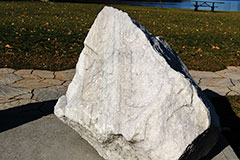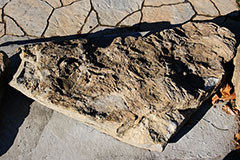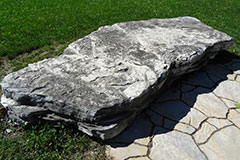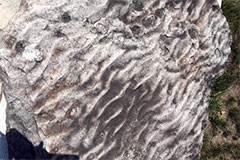Geological words used on the site sign, in the brochure, and on the website.
amphibole a group of generally dark-coloured, silicate or aluminosilicate minerals in igneous and metamorphic rocks, such as hornblende
amphibolite a metamorphic rock consisting mainly of amphibole and feldspar minerals
apatite a phosphate mineral
Archean the geological Eon, about 4 to 2.5 billion years ago, when the Earth’s crust and layers had just formed
basalt a fine grained, mafic, igneous rock lacking silica, produced by non-explosive volcanoes
bedding layers of sediment or rock ranging in thickness from centimetres to metres
bedrock the solid rock underlying unconsolidated deposits of sand and gravel, glacial till, etc.
biofilm a thin film of microorganisms
biotite a black mica mineral commonly found in igneous and metamorphic rocks
biosedimentary a sedimentary rock formed by biological processes, such as fossiliferous limestone
bioturbated the mixing of sediment by organisms, such as burrowing
brachiopod a bottom dwelling, marine animal with two shells found as fossils in the Ordovician age limestone of the Almonte area
bryozoa tiny, aquatic, colonial, invertebrate animals fossil structures found in the Ordovician age limestone of the Almonte area
calcite a calcium carbonate mineral CaCO3 which is a major constituent of the sedimentary rock limestone and the metamorphic rock marble
Cambrian the first geological time Period of the Paleozoic Era, between about 541 and 485 million years ago, before the Ordovician
Canadian Shield a large area of exposed igneous and metamorphic rock of Precambrian age that forms the ancient geological core of the North American continent
carbonate a sedimentary rock composed mainly of calcium carbonate, such as limestone and dolostone
Carboniferous a geological time Period of the Paleozoic Era, after the Devonian and before the Permian, between about 359 and 299 million years ago
cavity fill the deposition of minerals in a cavity or rock opening
Cenozoic the current geological time Era of the Phanerozoic Eon, from about 66 million years ago to the present
cephalopod a shelled, squid-like, marine, invertebrate animal found as straight, cone-shaped fossils in the limestone of the Almonte area
chalcopyrite a copper iron sulphide mineral important as an ore of copper
continental collision the impact of the Earth’s moving tectonic plates over tens of millions of years, such as the collision of India with Asia
coral solitary and colonial marine organisms that secret a hard calcareous exoskeleton found as fossils in the Ordovician age limestone of the Almonte area
craton a stable block of the Earth’s crust that forms the ancient core of a continent
Cretaceous the last geological time Period of the Mesozoic Era, after the Jurassic, between about 145 and 65 million years ago
crinoid a stalked, plant-like ‘sea lily’ animal found as fossils – circular plates or longer sections of stem columns – in the Ordovician age limestone of the Almonte area
cross-bedding inclined layers of granular sediment formed downstream by water or wind transport
dessication cracks also known as mud cracks, are formed as muddy sediment dries and contracts
Devonian a geological time Period of the Paleozoic Era, after the Silurian and before the Carboniferous, between about 419 and 358 million years ago
diabase a common, dark-coloured, mafic, intrusive igneous rock, which occurs mostly as shallow sheets in factures of older rock
diorite a speckled, coarse grained, intrusive igneous rock composed mainly of the minerals plagioclase feldspar, biotite, hornblende, and/or pyroxene
dolomite (i) a sedimentary rock more commonly known today as dolostone (ii) a calcium magnesium carbonate mineral CaMg(CO3)2
dolostone a sedimentary carbonate rock in the Almonte region with a high percentage of the magnesium-rich mineral dolomite CaMg(CO3)2
eon a division of geological time, such as the Phanerozoic Eon, from about 540 million years ago to the present, which consists of the Paleozoic, Mesozoic, Cenozoic Eras
era a division of geological time smaller than an Eon, such as the Paleozoic Era from about 541 to 252 million years ago, which consists of the Cambria, Ordovician, Silurian, Devonian, Carboniferous, and Permian Periods
evaporite a rock that forms by precipitation of dissolved minerals during the evaporation of seawater, such as halite and gypsum
fault a fracture in the bedrock along which movement has taken place
feldspar a group of rock forming minerals, which make up as much as 60% of the Earth’s crust, containing silicon, aluminum and oxygen with some potassium, calcium, or sodium
felsic an igneous rock that is rich in the light-coloured minerals feldspar and quartz
fold a bend created under tremendous heat and pressure, at great depths, from the plastic deformation of the bedrock by compression
foliation layering in metamorphic rock caused by the segregation of different minerals
fossil the remains, impression, or trace of a once living thing from a former geological time
fracture any kind of separation or break in a rock formation, such as joints or faults
garnet a group of rock forming minerals that have been used for thousands of years as gemstones and abrasives
gastropod a mollusk (snail) with a single, unchambered shell found as fossils in the Ordovician age limestone of the Almonte area
glacial action erosion, transportation, and deposition by glacier ice
glacial striations scratches or gouges cut into bedrock by boulders, gravel, and sand grains that are pushed / pulled along under a moving glacier
gneiss a metamorphic rock with a banded or foliated structure, typically coarse-grained and consisting mainly of the minerals feldspar, quartz, and mica
granite an intrusive igneous rock containing subequal proportions of alkali feldspar and plagioclase feldspar, at least 10% quartz, and lesser amounts of mica, magnetite, or hornblende.
granodiorite an intrusive igneous rock similar to granite, but containing more plagioclase feldspar than orthoclase feldspar
graphite a soft mineral, with the same chemical composition as diamond, which is composed exclusively of the element carbon
hematite an iron oxide mineral Fe2O3
Holocene the current geological time Epoch of the Quaternary Period, that began after the Pleistocene Epoch about 11,700 years ago.
igneous a rock formed from the solidification of magma at the surface of the Earth (extrusive) or underground (intrusive)
intercalated formed in distinctly alternating layers
joint a fracture or crack in bedrock with little or no displacement
Jurassic a geological time Period of the Mesozoic Era, after the Triassic and before the Cretaceous, between about 200 and 145 million years ago
lineation the alignment of minerals due to metamorphic deformation and/or recrystallation during deformation
limestone a sedimentary carbonate rock with a high percentage of the calcium-rich mineral calcite Ca(CO3)2
mafic an igneous rock rich in iron and magnesium silicate minerals such as olivine and amphibole
marble a metamorphic carbonate rock with a high percentage of the calcium-rich mineral calcite Ca(CO3)2
marine synonym of saltwater and oceanic
Mesozoic a geological time Era, from about 251 to 65 million years ago, divided into the Triassic, Jurassic, and Cretaceous Periods
metadiorite metamorphosed diorite (an intrusive igneous rock)
metagabbro metamorphosed gabbro (an intrusive igneous rock of mafic composition)
metamorphic a rock that was created under conditions of high heat and pressure from a pre-existing rock, such as marble formed from limestone
mica a group of silicate minerals that form in flexible sheets and flakes, such as biotite, muscovite, phlogopite
migmatite a metamorphic rock with light-coloured bands in which partial melting has occurred
monzonite an intrusive igneous rock (intermediate between syenite and diorite) containing approximately equal amounts of orthoclase and plagioclase feldspars with very little quartz
muscovite a silver-gray mica mineral found in many igneous and metamorphic rocks
mylonite a fine grained metamorphic rock created by ductile deformation during the intense shearing of folding and faulting
Ordovician a geological time Period of the Paleozoic Era, after the Cambrian and before the Silurian, between about 485 and 444 million years ago
orthocone the long, cone-shaped fossil shell of a squid-like marine invertebrate found in the limestone of the Almonte area
orthogonal at right angles
ossicle a stem disk of a fossil crinoid found in the Ordovician age limestone of the Almonte area
Paleozoic a geological time Era of the Phanerozoic Eon, from about 541 to 252 million years ago, divided into the Cambrian, Ordovician, Silurian, Devonian, Carboniferous, and Permian Periods
parting lineation (also known as current lineation) a subtle sedimentary structure in which sand grains are aligned in parallel lines or grooves
pegmatite an igneous rock containing large crystals formed by the very slow cooling of a granitic magma
pelecypod a bivalve mollusk (clam) characterized by two mirror image shells found as fossils in the Ordovician age limestone of the Almonte area
period a subdivision of a geological time era, such as the Ordovician Period of the Paleozoic Era
Permian the last geological time Period of the Paleozoic Era, between about 299 and 252 million years ago
Phanerozoic a geological time Eon, about 541 million years ago to the present, consisting of the Paleozoic, Mesozoic, and Cenozoic Eras
plagioclase a member of the feldspar mineral group and, together with quartz, the most common of the rock forming minerals
Pleistocene a geological time Epoch of the Quaternary Period, after the Pliocene and before the Holocene, between about 2.6 million and 11,700 years ago
Precambrian a geological time Supereon, from about 4.6 billion to 541 million years ago, subdivided into the Proterozoic, Archean, and Hadean Eons
Proterozoic a geological time Eon of the Precambrian Supereon, from about 2.5 billion to 541 million years ago, subdivided into the Paleoproterozoic, Mesoproterozoic, and Neoproterozoic Eras
protolith the original rock from which a metamorphic rock formed
pyrite an iron sulphide mineral FeS2 which forms at both high and low temperatures and is found in igneous, metamorphic, and sedimentary rocks
pyroxene a large group of silicate minerals, generally containing calcium, magnesium, and iron, found in many igneous and metamorphic rocks
pyrrhotite an iron sulphide mineral and common trace component of mafic igneous rocks
quartz a very common mineral of the Earth’s crust, silicon dioxide SiO2, found in igneous, metamorphic, and sedimentary rocks
quartzite a metamorphic rock formed by the alteration of sandstone through heating and pressure
quartzofeldspathic containing quartz and feldspar
Quaternary the current geological time Period of the Cenozoic Era, from about 2.5 million years ago to the present, that follows the Tertiary
ripple marks undulating sedimentary structures formed by the wind, or by currents of water, or by the agitation of water in wave action
rugose coral an extinct solitary coral, sometimes referred to a ‘horn coral’ found in the Ordovician age limestone of the Almonte area
sandstone a sedimentary rock composed mostly of sand-sized grains cemented together
schist a mica rich metamorphic rock characterized by flat mineral grains aligned into thin layers
sedimentary a rock formed from (i) the lithification of sediment, such as sandstone, or (ii) precipitation from water, such as gypsum, or (iii) consolidation of plant or animal matter, such as coal, or (iv) secretions of organisms, such as limestone
schistose having a laminar structure like that of schist
shale a fine-grained sedimentary rock formed from mud
Silurian a geological time Period of the Paleozoic Era, after the Ordovician and before the Devonian, between about 444 and 419 million years ago
sponge aquatic invertebrate animals, having a porous internal framework, occurring in sessile colonies found as fossils in the Ordovician age limestone of the Almonte area
stromatolites layered dome-like structures, formed in shallow water by the trapping, binding, and cementation of sedimentary grains by biofilms of cyanobacteria (blue-green algae) found as fossils in the Ordovician age sedimentary rocks of the Almonte area
syenite a coarse-grained intrusive igneous rock, similar in composition to granite but with very little or no quartz, having alkali feldspar, usually orthoclase, as the dominant mineral
syenodiorite generally considered a synonym of monzonite
Tertiary the first geological period of the Cenozoic Era, from about 66 to about 2.5 million years ago, before the Quaternary
till an unsorted glacial sediment
trace fossil a fossilized trail, track, burrow, etc., created by an organism in soft sediment and later preserved as a structure in sedimentary rock found in the Ordovician age limestone of the Almonte area
tremolite a member of the amphibole group of silicate minerals which forms by the metamorphism of sedimentary rocks rich in the minerals dolomite and quartz
Triassic the first geological time Period of the Mesozoic Era, before the Jurassic, between about 251 and 199 million years ago
trilobite an extinct marine arthropod with a flattened, oval, three-sectioned exoskeleton – cephalon (head), thorax (body), pygidium (tail) found as fossils in the Ordovician age limestone of the Almonte area
vug a rock cavity lined with mineral crystals






















